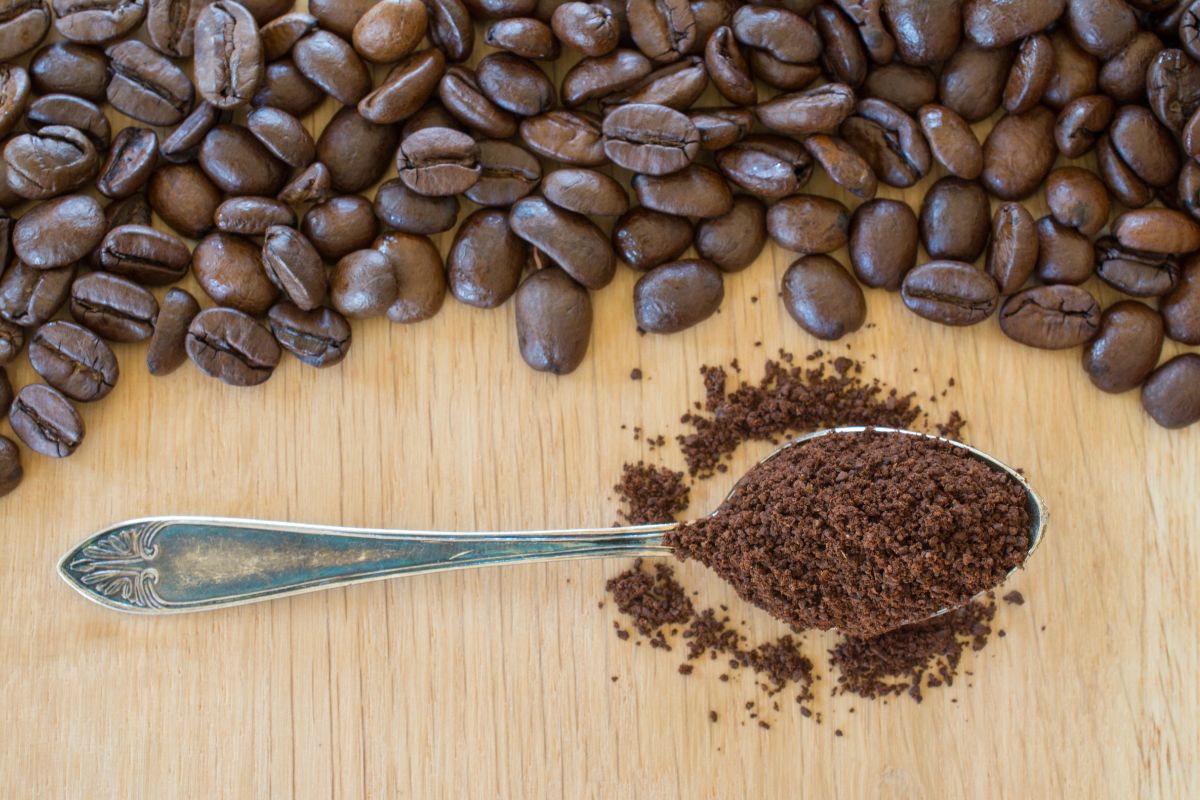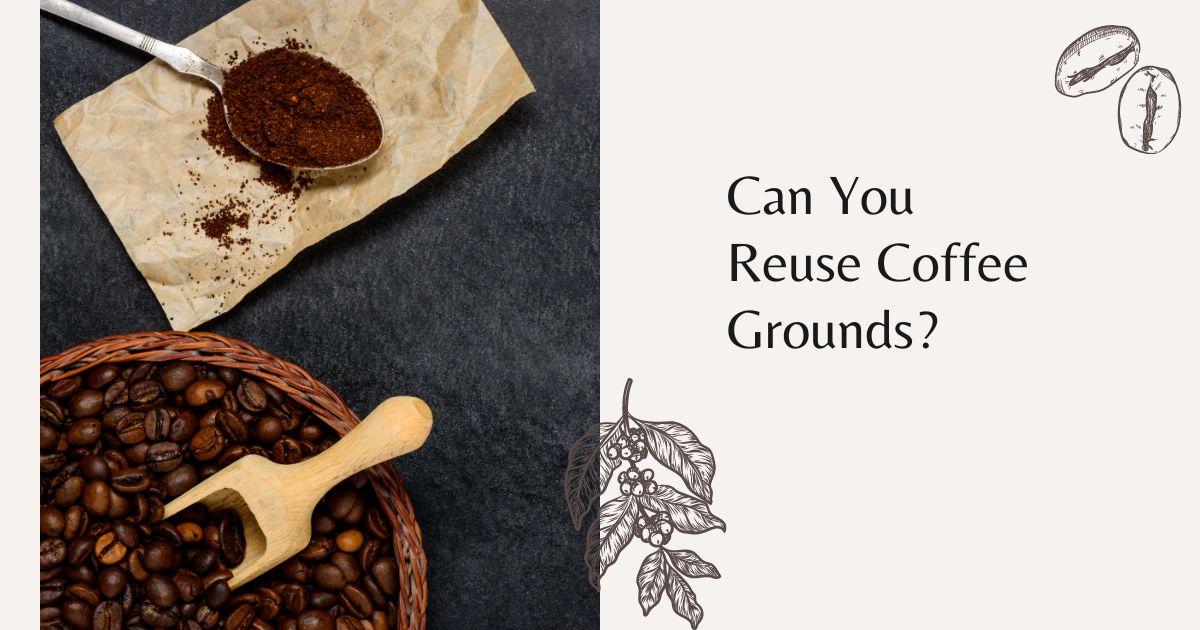Reusing Coffee Grounds
You may wonder, can you reuse coffee grounds? While it won’t make you sick, coffee enthusiasts might not prefer this practice.
However, if you mask the coffee taste with cream and sugar, you may notice a slight difference between the two cups. When you brew coffee using fresh grounds, most of the flavor ends up in that initial cup. Consequently, reusing coffee grounds results in less flavorful and potentially bitter coffee.

How Many Times Can You Reuse Coffee Grounds?
The number of times you can reuse coffee grounds depends on several factors, including your taste preferences and the brewing method you use. Generally, coffee grounds start to lose their flavor and aromatic properties with each subsequent use. After the first brew, the most desirable compounds leave behind a weaker and less flavorful coffee.
If you’re someone who doesn’t mind a weaker cup of coffee or frequently adds cream and sugar to improve the taste, you might be able to reuse the grounds one or two more times. However, remember that the flavor will continue to diminish with each reuse.
On the other hand, if you are a coffee enthusiast who appreciates the full range of flavors and aromas in your coffee, it’s best to use fresh grounds for each brew. Fresh, high-quality coffee grounds will ensure you get the best possible cup of coffee with each preparation.
Ultimately, deciding to reuse coffee grounds and how often to do so is subjective and depends on individual taste preferences. Experimenting with different brewing techniques and the number of reuses can help you find the balance that suits your palate.
What to Do With Used Coffee Grounds
After completing the brewing process, many coffee drinkers often dispose of the grounds used to make their perfect espresso or cold brew. However, true baristas understand what to do with coffee grounds by finding various practical ways to reuse them right at home. Here are some uses for used coffee grounds:
DIY Coffee Scrub
Coffee grounds are a natural exfoliant to mix into a face or body scrub. Combining one cup of coffee grounds from freshly brewed coffee with six tablespoons of coconut or jojoba oil and three tablespoons of sea salt or white sugar creates an effective scrub. Apply the mixture like a mask and gently rub it onto your skin.
Clean Pots and Pans
Dried, used coffee grounds are abrasive and acidic, making them ideal for cleaning pots, pans, and dishes with stubborn stains. You must soak the cookware for thirty minutes in hot water, then gently rub coffee grounds onto the surface to remove residue.

Enjoy a Coffee Ground Bath
The residual caffeine in coffee grounds can aid the body’s natural repair processes. Create a “coffee ground bath bomb” by placing one cup of used grounds in a nut milk bag or cheesecloth pouch and adding it to a warm bath with half a cup of Epsom salts for extra relaxation.
Hair Rinse
Soaking hair in wet coffee grounds can add depth and shine to the hair’s color, as the acid in the coffee helps strip away buildup.
Nourish Plant Roots
Acid-loving plants benefit from coffee grounds when placed at their base. However, be cautious, as coffee grounds may inhibit the growth of some plants.
Repel Slugs, Cats, and Rabbits
Sprinkling coffee grounds in the garden may reduce the presence of slugs, and the smell might deter cats and rabbits.
Eliminate Odors
Dry used coffee grounds and place them in your refrigerator or other areas of your home to absorb and eliminate unwanted smells.
With these creative uses, you can make the most of your coffee grounds and reduce waste while enjoying additional benefits around the house and garden.
Are Coffee Grounds Good Fertilizers?
Yes, coffee grounds can be good fertilizers and provide several benefits when gardening and composting. Here are some reasons why coffee grounds make a valuable addition to fertilizing:
- Nitrogen source: Coffee grounds are rich in nitrogen, an essential nutrient for plant growth. Nitrogen helps with leafy green growth and overall plant development.
- pH balance: While coffee grounds are slightly acidic, they become more neutral as they break down in the soil. This can help balance the soil’s pH levels, especially if it is too alkaline.
- Micronutrients: Coffee grounds also contain small amounts of micronutrients like potassium, phosphorus, and magnesium, which benefit plant health.
However, it’s essential to use coffee grounds in moderation and avoid using them as the sole fertilizer. Excessive amounts of coffee grounds can cause soil pH to become too acidic, which may negatively impact some plants. Mixing coffee grounds with other compost materials or soil amendments is best to create a balanced and nutritious fertilizer.
Also, when using coffee grounds in the garden, it’s a good idea to sprinkle them around plants or work them into the soil to avoid forming a thick layer that could repel water and create an oxygen barrier.
In summary, coffee grounds can be an eco-friendly and cost-effective way to fertilize your garden. Still, you should use them wisely with other compost materials to maintain a healthy and thriving plant environment.
How to Reuse Coffee Grounds for Skin
Reusing coffee grounds for skin can offer several benefits due to their exfoliating and antioxidant properties. Here’s how you can incorporate coffee grounds into your skincare routine:
Under Eye Treatment
Applying slightly dampened coffee grounds under your eyes can help reduce puffiness. The caffeine in coffee usually constricts blood vessels and reduces swelling. However, be gentle when applying, as the skin around the eyes is delicate.
Cellulite Treatment
Some people believe that coffee grounds can temporarily reduce the appearance of cellulite. To try this, mix coffee grounds with a bit of water to form a paste and massage it onto the affected areas in a circular motion. While the effects may be temporary, massaging can improve blood circulation.
Toning Properties
Coffee contains antioxidants that can help tone the skin. You can create a toner by steeping used coffee grounds in hot water for a few minutes. Once the water cools down, strain the grounds, and use the liquid as a toner on your face.

Key Takeaways
You will note that reusing coffee grounds for brewing more than one cup results in a bitter, over-extracted outcome. On the other hand, letting the grounds dry first leads to a sour and disappointing cup.
Fortunately, ground coffee proves remarkably versatile, offering various alternative uses that give them a second life and help you save money. Whether you are an avid gardener, concerned about skin health, or desire to enhance your wood tables’ shine, there are fantastic ways for coffee grounds recycling.

